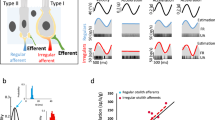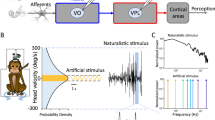Summary
In the present study we have investigated in the awake cat the response dynamics of vestibular nuclei neurons to visual or/and otolith stimulation elicited by vertical linear motion. Of the 53 units tested during sinusoidal motion at 0.05 Hz (9.1 cm/ s), 1 (1.9%) was responsive to the otolith input only, 13 (24.5%) were influenced by the visual input only and 23 (43.4%) responded to both modalities. Neurons were excited either during upward or downward animal or visual surround movement. Most units displayed a firing rate modulation very close to motion velocity. All the neurons receiving convergent visual and otolith inputs (0.05 Hz, 9.1 cm/s) exhibited synergistic patterns of response. Motion velocity coding was improved in terms of inputoutput phase relationship and response sensitivity when visual and otolith signals were combined. Depending on the units, visual-otolith interactions in single neurons could follow a linear or a nonlinear mode of summation. The dynamic characteristics of visual-otolith interactions were examined in the 0.05 Hz–0.50 Hz frequency bandwidth. Visual signals seemed to predominate over otolith signals at low stimulus frequencies (up to 0.25 Hz), while the contrary was found in the higher frequency range of movement (above 0.25 Hz). The effects of visual stabilization (VS: suppression of visual motion cues) was observed in a small sample of units. As a rule, VS induced a reduction in the amplitude of unit response as compared to visual + otolith stimulation, the lower the motion frequency, the more pronounced the attenuation. VS also decreased the amplitude of the otolith-dependent component of response. The possible modes of visual-vestibular interactions in single cells are discussed. The present study supports the hypothesis that visual and vestibular motion cues are weighted according to their internal relevance.
Similar content being viewed by others
References
Allum JHJ, Graf W, Dichgans J, Schmidt CL (1976) Visualvestibular interactions in the vestibular nuclei of the goldfish. Exp Brain Res 26: 463–485
Amblard B, Cremieux J (1976) Role of visual motion information in the maintenance of postural equilibrium in man. Agressologie 17C: 25–36
Ansorge K, Grüsser-Cornehls U (1977) Visual and visual-vestibular responses of frog cerebellar neurons. Exp Brain Res 29: 445–465
Barthélémy J, Xerri C, Borel L, Lacour M (1988) Neuronal coding of linear motion in the vestibular nuclei of the alert cat. II. Response characteristics to vertical visual stimulation. Exp Brain Res 70: 287–298
Bauer R, Hoffman KP (1980) Responses of vestibular nucleus neurons in the visually deprived cat to optokinetic stimulation of central parts of the visual field. Neurosci Lett 17: 237–241
Bisti S, Maffei I, Piccolino L (1974) Visuo-vestibular interactions in the cat superior colliculus. J Neurophysiol 22: 146–155
Blanks RHI, Precht W (1976) Functional characterization of primary vestibular afferents in the frog. Exp Brain Res 25: 369–390
Blanks RHI, Precht W (1983) Responses of units in the rat cerebellar flocculus during optokinetic and vestibular stimulation. Exp Brain Res 53: 1–15
Brodal A, Pompeiano O, Walberg F (1962) The vestibular nuclei and their connection. Anatomical and functional correlations. Oliver and Boyd, London
Buettner UW, Büttner U (1979) Vestibular nuclei activity in the alert monkey during suppression of vestibular and optokinetic nystagmus. Exp Brain Res 37: 581–593
Büttner U, Buettner UW (1978) Parietal cortex (2v) neuronal activity in the alert monkey during natural vestibular and optokinetic stimulation. Brain Res 153: 392–397
Cazin L, Precht W, Lannou J (1980) Optokinetic responses of vestibular nucleus neurons in the rat. Pflügers Arch 384: 31–38
Daunton N, Thomsen D (1979) Visual modulation of otolith-dependent units in cat vestibular nuclei. Exp Brain Res 37: 173–176
Daunton N, Christensen C, Thomsen D (1981) Visual modulation of otolith responses: a paradigm for the study of self-motion perception and its neural substrate. In: Gualtierotti T (ed) The vestibular system: function and morphology. Springer, New York Heidelberğ-Berlin, pp 452–462
Dichgans J, Schmidt CL, Graf W (1973) Visual input improves the speedometer function of the vestibular nuclei in the goldfish. Exp Brain Res 18: G319–322
Fernandez C, Goldberg JM (1971) Physiology of the peripheral neurons innervating semicircular canals of the squirrel monkey. II. Response to sinusoidal stimulation and dynamics of peripheral vestibular system. J Neurophysiol 34: 661–675
Fernandez C, Goldberg JM (1976) Physiology of peripheral neurons innervating otolith organs of the squirrel monkey. III. Response dynamics. J Neurophysiol 39: 996–1008
Ghelarducci B, Ito M, Yagi N (1975) Impulse discharges from flocculus cells of alert rabbits during visual stimulation combined with horizontal head rotation. Brain Res 87: 66–72
Henn V, Young LR, Finley C (1974) Vestibular nucleus units in alert monkeys are also influenced by moving visual fields. Brain Res 71: 144–149
Horn G, Hill RM (1969) Modifications of receptive fields of cells in the visual cortex occurring spontaneously and associated with body tilt. Nature (Lond) 221: 186–188
Horn KM, Miller SW, Neilson HC (1983) Visual modulation of neuronal activity within the rat vestibular nuclei. Exp Brain Res 52: 311–313
Kawano K, Sasaki M (1984) Response properties of neurons in the posterior parietal cortex of monkey during visual-vestibular stimulation. I. Visual tracking neurons. J Neurophysiol 51: 340–352
Keller EL, Daniels P (1975) Oculomotor related interaction of vestibular and visual stimulation in vestibular nucleus cells in alert monkey. Exp Neurol 46: 187–198
Keller EL, Precht W (1979) Visual-vestibular responses in vestibular nuclear neurons in the intact and cerebellectomized alert cat. Neuroscience 4: 1599–1613
Kornhuber HH, Da Fonseca JS (1964) Optovestibular integration in the cat's cortex: a study of sensory convergence on cortical neurons. In: Bender B (ed) The oculomotor system, pp 239–277
Kubo T, Matsunaga T, Igarashi M (1979) Vestibular unitary responses to visual stimulation in the rabbit. Acta Otolaryngol 88: 117–121
Lannou J, Cazin L, Haman KF (1980) Response of central vestibular neurons to horizontal linear acceleration in the rat. Pflügers Arch 385: 123–129
Lacour M, Vidal P, Xerri C (1981) Visual influences on vestibulospinal reflexes during vertical linear motion in normal and hemilabyrinthectomized monkey. Exp Brain Res 43: 383–394
Lestienne F, Soechting JF, Berthoz A (1977) Postural readjustments induced by linear motion of visual scenes. Exp Brain Res 28: 363–384
Löwenstein O, Sand A (1940) The mechanism of the semicircular canal. A study of responses of single-fibre preparations to angular accelerations and to rotation at constant speed. Proc R Soc London Ser B 129: 256–275
Lund S, Pompeiano O (1968) Monosynaptic excitation of alpha motoneurons from supra-spinal structures in the cat. Acta Physiol Scand 73: 1–21
Melvill Jones G, Milsum JH (1969) Neural response of the vestibular system to translational acceleration. In: Supplement to conference on systems analysis approach to neurophysiological problems. Brainerd, Minn, pp 8–20
Melvill Jones G, Milsum JH (1971) Frequency response analysis of central vestibular unit activity resulting from rotational stimulation of the semi-circular canals. J Physiol 219: 191–215
Nashner L (1971) A model describing the vestibular detection of body sway motion. Acta Otolaryngol 72: 429–436
Nashner L, Berthoz A (1978) Visual contribution to rapid motor responses during postural control. Brain Res 150: 403–407
Perachio AA (1981) Responses of neurons in the vestibular nuclei of awake squirrel monkeys during linear acceleration. In: Gualtierotti T (ed) The vestibular system: function and morphology. Springer, New York Heidelberg Berlin, pp 443–451
Precht W, Simpson H, Llinás R (1976) Responses of Purkinje cells in rabbit nodulus and uvula to natural vestibular and visual stimuli. Pflügers Arch 367: 1–6
Robinson DA (1977) Linear addition of optokinetic and vestibular signals in the vestibular nucleus. Exp Brain Res 30: 447–450
Schor RH, Miller AD (1982) Relationship of cat vestibular neurons to otolith-spinal reflexes. Exp Brain Res 47: 137–144
Steinhausen W (1933) Über die Beobachtung der Cupula in den Bogengangsampullen des Labyrinths des lebenden Hechts. Arch Ges Physiol 232: 500–512
Talbott RE (1980) Postural reactions of dogs to sinusoidal motion in the peripheral visual field. Am J Physiol 239: 71–79
Vidal PP, Gouny M, Berthoz A (1978) Rôle de la vision dans le déclenchement de réactions posturales rapides. Arch Ital Biol 116: 281–291
Waespe W, Henn V (1977) Neuronal activity in the vestibular nuclei of the alert monkey during vestibular and optokinetic stimulation. Exp Brain Res 27: G523–538
Waespe W, Henn V (1978) Conflicting visual-vestibular stimulation and vestibular nucleus activity in alert monkeys. Exp Brain Res 33: 203–211
Waespe W, Henn V (1979) The velocity response of vestibular nucleus neurons during vestibular, visual, and combined angular acceleration. Exp Brain Res 37: 337–347
Waespe W, Henn V (1981) Visual-vestibular interaction in the flocculus of the alert monkey. II. Purkinje cell activity. Exp Brain Res 43: 349–360
Wilson V, Melvill Jones G (1979) Mammalian vestibular physiology. Plenum Press, New York
Xerri C, Barthelemy J, Harlay F, Borel L, Lacour M (1987) Neuronal coding of linear motion in the vestibular nuclei of the alert cat. I. Response characteristics to vertical otolith stimulation. Exp Brain Res 65: 569–581
Young LR (1970) On visual-vestibular interactions. In Proceedings of the fifth Symposium on the role of the vestibular organs in space. NASA SP-314: 205–210
Zacharias GL, Young LR (1981) Influence of combined visual and vestibular cues on human perception and control of horizontal rotation. Exp Brain Res 41: 159–171
Author information
Authors and Affiliations
Rights and permissions
About this article
Cite this article
Xerri, C., Barthelemy, J., Borel, L. et al. Neuronal coding of linear motion in the vestibular nuclei of the alert cat. Exp Brain Res 70, 299–309 (1988). https://doi.org/10.1007/BF00248355
Received:
Accepted:
Issue Date:
DOI: https://doi.org/10.1007/BF00248355




